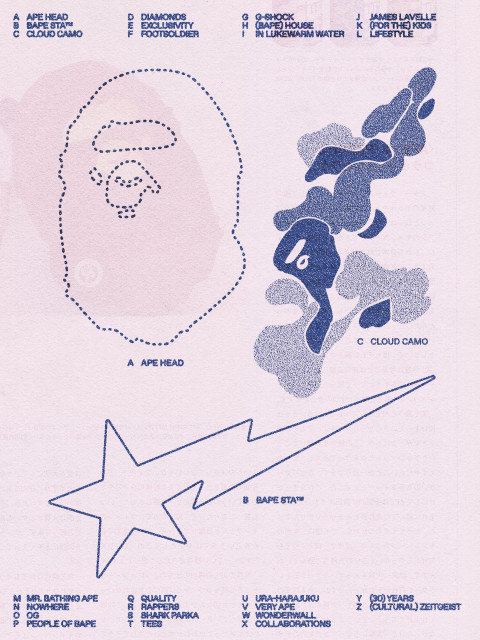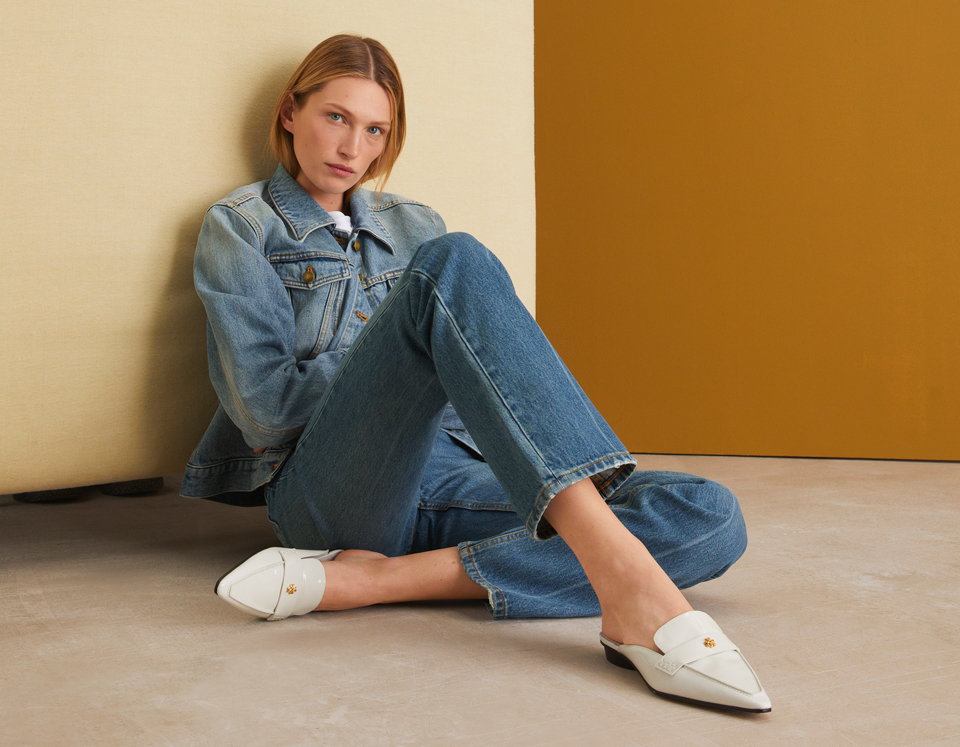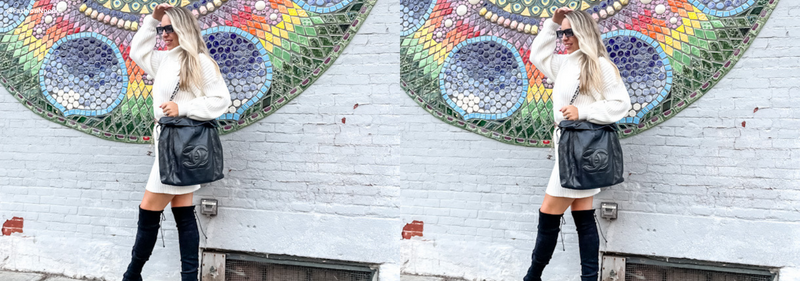The A-Z Guide to BAPE
Celebrating 30 Years of Ape

Founded in Japan by designer NIGO in 1993, BAPE remains not only a streetwear staple, but an undeniable cultural phenomenon. From Soulja Boy’s unforgettable 2007 mantra “I got me some Bathing Apes,” to today's triumphant return of the BAPE STA™(by way of multiple exclusive SSENSE colorways), BAPE is no less relevant now than it was 30 years ago. Here, find out how NIGO (who recently added artistic director of Kenzo to his extensive résumé) built the brand, and all of the creative collaborators and famous fans that contributed along the way. This is a taxonomy of BAPE.

Every brand needs a logo. When mysterious Japanese graphic designer Sk8thing devised the brand’s ape head logo, he leaned into NIGO’s love for the classic 1968 film while paying tribute to quintessential American workwear labels that inspired early designs and production methods, such as Ben Davis. The ape head logo has appeared on pretty much everything you could think of since, becoming a globally recognised symbol of streetwear.
Perhaps the most iconic style on the BAPE roster, the BAPE STA™ (named after the striking star emblem across each side of the upper) is still turning heads since its initial 2000 release. The low-top sneaker’s overall design has spawned its own rich legacy thanks to the brand’s use of bold tones and premium materials, and was instrumental in the meteoric rise of BAPE in the mid-2000s. Among the hundreds of color variations released, perhaps the most coveted is the 2007 collaboration with Kanye West.


Designed by Sk8thing, the famous Cloud Camo print has featured on everything from field jackets to toilet rolls and is still one of the most well-known symbols of the brand today. The pattern was inspired by the traditional US duck hunter camouflage and is regularly given alternate bright color schemes in the vein of pop artist and NIGO idol Andy Warhol. Since the debut of that so-called 1st Camo, the brand has released its own spin on various other classic military and hunting patterns, including the tribal-style ASAT print, and Russian Berezka-style digi camo.

NIGO’s iced-out era in the mid-2000s set the tone for BAPE’s fresh post-millennium identity. Through his friend Jacob the Jeweler, of Jacob & Co, NIGO designed custom jewel-encrusted Ape head pendants for the brand in the early ’00s. NIGO was able to meet his influence and fellow creative force Pharrell Williams, and the two became business partners and took the flashy, bling-focused style to a new dimension in the form of BAPE collabs and the establishment of the Billionaire Boys Club label.

It’s the tried and tested formula for any streetwear giant. Scarcity of stockists and limited-quantity product drops in BAPE’s early years paved the way for its cult success. In the pre-internet era, BAPE relied on cryptic marketing and selective seeding in order to align itself with the hip underground demographic of the 1990s. Because imports were the only way most western consumers could get their hands on ape gear, the desirability of the brand only increased.


FOOTSOLDIER began in 2001 as an outlet to showcase and sell the ever-expanding BAPE footwear line. The sneaker boutiques are designed to look different than your average shoe store, stylized with futuristic interiors including the iconic conveyor belt display in the Daikanyama store, and an elevator to transport sneakers in the Kyoto shop. It also houses the archive of the classic BAPE STA™ series.

The partnership between BAPE and G-SHOCK is significant as being the hard-wearing Casio line’s first collaborative project and one of BAPE’s earliest, with the first watch released in 1998. Since the mid-2000s, a BAPE-curated G-SHOCK has become a seasonal mainstay, with various tweaks to the shape and a multitude of face designs, even getting the iced-out treatment as a one-off for Williams courtesy of Jacob the Jeweler in 2009.

In the 2000s, BAPE’s mythology expanded to include NIGO’s very own former abode, known as the BAPE HOUSE. The home served as a treasure trove of all things BAPE, and housed the designer’s personal art collection and archive of hyper-rare vintage pieces in the basement. The property was the subject of a number of documentaries in the 2000s, with NIGO giving personal guided tours and taking viewers through extensive vaults of everything from vintage Louis Vuitton luggage to Coca-Cola memorabilia to figurines to unreleased BAPE gear and high-end mid-century furniture. In 2013, for BAPE’s twentieth birthday celebrations, the home was opened up to the public as BAPELAND, an archive exhibition.


When conceptualising a brand to fit into his cocurated NOWHERE retail store, NIGO tasked Sk8thing to assist in devising an identity. After a five-hour marathon, the artist proposed the ape head logo and the name “a bathing ape in lukewarm water,” a phrase satirizing the apathetic nature of young, wealthy Japanese people by comparing their complacency to that of someone who’s lingered in the bath for so long that the temperature has grown tepid. NIGO appreciated the irony in this statement, given the intended consumer, and shortened it to A BATHING APE.

The legendary UK DJ, trip hop pioneer, and friend of NIGO was instrumental in building hype around BAPE during the brand’s early years, particularly in Britain, where he was NIGO’s go-to seed alongside Stone Roses singer and solo artist Ian Brown. Around the time of the UNKLE musical project with DJ Shadow in 1998, Lavelle was frequently seen head-to-toe in ape gear, notably the camo print APESTA low-top sneakers and countless ape T-shirts, and even released NIGO’s LP through his Mo’Wax imprint in 2000.

In the mid-to-late 2000s, as BAPE’s global appeal was reaching unprecedented new heights, the brand issued BAPE’s kids line. Fronted by the “cuter” new mascot Baby Milo (illustrated in the same blocky style as Williams on the cover of his 2006 solo album ), this new offering featured T-shirts with kid-friendly graphics, playful accessories, and more, eventually becoming a huge hit in Hong Kong in the early 2010s.

BAPE’s expansion as a lifestyle brand reached a peak in 2002, with the opening of BAPE CAFE?! in Aoyama, Japan. Bringing together NIGO’s passions for dining and design, the restaurant was nestled between the popular Harajuku and Sendagaya shopping districts, and featured ape head tables with camo-upholstered stools. BAPE CAFE?! joined NIGO’s other nonfashion ventures, which included the BAPE CUTS beauty salon and the BAPE GALLERY, housed in the Kyoto store, which acted as a space for BAPE-sponsored art events and exhibitions.
Born out of NIGO’s love of British formalwear, Mr. Bathing Ape launched as the sartorial diffusion line of BAPE in 2011. NIGO cited Vivienne Westwood, Prince Charles, and classic Savile Row tailoring as key inspirations for the concept, believing that the loyal but aging fans from BAPE’s inception would appreciate the more put-together collection, which featured dressy, vintage-inspired pieces with trademark BAPE eccentricities such as camo print scarves and ties, or ape head shirting appliqués.

NOWHERE is where BAPE’s story began. Under the mentorship of Hiroshi Fujiwara, NIGO and his friend Jun Takahashi of UNDERCOVER, opened the independent retail space in 1993, initially stocking it with Takahashi’s first UNDERCOVER designs as well as a curated selection of vintage pieces selected by NIGO. Named after The Beatles’s song “Nowhere Man,” the store also carried Tetsu Nishiyama and Sk8thing’s FORTY PERCENT AGAINST RIGHTS label, which would lay the foundations for WTAPS, as well as AFFA, projects from Takahashi and Hiroshi Fujiwara. NOWHERE was a huge success with the kids of Harajuku, filling a cultural void and inspiring NIGO to start BAPE the very same year.
Many of BAPE’s early designs are extremely coveted today, with older pieces routinely fetching between three and four figures on auction sites and at resale stores. Among some of the rarer items are any early to mid-1990s pre-BAPE tag T-shirts, printed onto beefy blanks—complete with Hanes or Oneita neck labels. Products such as the Supreme x BAPE blue camo box logo T-shirt from ‘98 will set you back around $10,000 USD on Grailed, whereas ‘90s camo field jackets sell for around the $300–$500 mark. Even a BAPE pin set in pristine condition could cost you up to $200.
Although the main creative force behind BAPE was NIGO, there was a strong supporting cast of young designers and artists who shared his vision and helped build the brand into what it is today. Graphic designers such as Sk8thing and Kazuki Kuraishi assisted NIGO in delivering his concepts early on, while it was tastemaking recording artists like James Lavelle, Cornelius, and Cherie who provided necessary clout to connect BAPE with the music industry. Figures such as brand manager Dan Doyle, consultant turned Cav Empt director Toby Feltwell, and Craig Ford of anon* have also been key players in BAPE’s rise, particularly in the European market.

The key to BAPE’s longevity in an increasingly saturated streetwear scene is its approach to production. NIGO’s early move to produce BAPE garments in factories that specialized in workwear labels was a master stroke that established the brand’s reputation for quality. Likewise, BAPE’s Japanese-made products rightfully warranted the premium price tag thanks to their traditional high-level craftsmanship. Working with other brands of the same ilk when it came to quality, such as Supreme and Porter, only cemented this position.
BAPE’s relationship with hip-hop stretches nearly as far back as the brand’s inception. In 1996, The Notorious B.I.G. was photographed with a 1st Camo jacket draped over his shoulders and the label has been synonymous with the culture ever since. The link that began in the early 2000s between Williams and N.E.R.D. is well known, and this helped establish BAPE as an influence in hip-hop, eventually seen on the likes of Kanye West as well as featuring in the videos of Lil Wayne and Soulja Boy in the latter part of the decade. The association continues to this day, with the brand being adopted by newer artists like 21 Savage.


BAPE is a brand known for its bold visuals, and one of its core styles, the shark parka, is just as notorious for its unusual graphic placement. The full-zip hoodie, which does right up to conceal the wearer's face, features a shark eye and teeth appliqué on the front of the hood. A BAPE-head favorite, the shark parka was most famously seen on Williams in the video for Fabolous’s “Tit 4 Tat” in 2004, the same year as the hoodie’s release.
Graphic T-shirts are the bread and butter of any streetwear label, including BAPE. They epitomize the attitude and ethos of the brand. For BAPE, the simplicity of the logo was ideal for two-color screen printing, which NIGO did by hand in his Tokyo studio in the early days. Fast forward to the present, and BAPE is still applying the same approach when it comes to designing its bold, recognizable graphics.

Though streetwear as a whole stems from the reappropriation of workwear labels and aesthetics by American brands and artists, it was the Japanese who helped breathe new life into it in the ‘90s via the Ura-Harajuku scene. A fresh crop of exciting brands including BAPE, UNDERCOVER, and WTAPS emerged from this burgeoning youth movement, which centered around the NOWHERE store and street publications such as , , and .

In 1997, BAPE launched Very Ape, a capsule of printed T-shirts made in the UK that was sold at hip London boutiques like Slam City Skates, and subsequently seen on the likes of Ad-Rock from the Beastie Boys. With its Nirvana-referencing graphics, the collection played an important role in marketing BAPE in the UK, as up until then it had been hard to obtain via imports, and this direction eventually culminated in the first London BAPE store in 2002.

Revered Japanese interior design studio Wonderwall is responsible for the aesthetics of BAPE’s retail locations, a partnership formed in 1997 when founder Masamichi Katayama met NIGO, who was looking for somebody to renovate the NOWHERE space. Katayama was given free reign over the design and revolutionized merchandising techniques to create something reminiscent of an art gallery. Sixty stores later, BAPE’s connection to Wonderwall is still going strong.

BAPE is a label synonymous with collaboration, with some of the joint-designed pieces more famous than those from its own line. The process was established early on in the BAPE timeline, working with fellow Uru-Hara labels such as WTAPS, before uniting streetwear kingpins Supreme and Stüssy in the late ‘90s. It wasn’t just clothing brands that got the BAPE treatment—BAPE branched out to work with era-defining artists such as Takashi Murakami, KAWS, Stash, and Futura to create limited-edition items, too. The most surprising collab might have to be the 2001 Pepsi can, with a price tag of less than a dollar—making it the cheapest BAPE item ever available at retail value. Today, the list of collaborators is long and ever-growing, with key partnerships between the likes of Marvel, adidas, Porter, and Comme des Garçons defining the brand in the modern era.
This year marks BAPE’s thirtieth anniversary, a testament to its position as a streetwear powerhouse. Since its inception three decades ago, the label has been able to transcend the norms of most clothing brands to become a global cultural phenomenon, pushing the boundaries of design and consumerism in the process.
Being at the forefront of streetwear’s rise to global dominance over the last three decades, BAPE’s influence on alternative mainstream culture is evident. From its associations with cutting-edge record labels like Mo’Wax in the ‘90s, celebrity fans such as the late Robin Williams (a BAPE store regular and early champion of the brand) to the sustained popularity intertwined with hip-hop in the 2000s, BAPE has continued to appeal to the new generation.
 A Look for Every Kind of Valentine's Day *Team SN's picks are selected based on products we truly love. Note: this article does contain affiliate links, and we will receive a commission if you purchase a product linked here. Something Navy also retains a percent of revenue from the third party brand products sold on Somethingnavy.com.
A Look for Every Kind of Valentine's Day *Team SN's picks are selected based on products we truly love. Note: this article does contain affiliate links, and we will receive a commission if you purchase a product linked here. Something Navy also retains a percent of revenue from the third party brand products sold on Somethingnavy.com.  Editor's Favorite: The Runway Jeans The perfect pair of jeans are like a character actor. They’re not the protagonist of the story but without them, the movie wouldn’t work as well. In the blockbuster film called New York Fashion Week Spring 2023, the ones that editors couldn’t stop talking about came straight from our runway. They’re high-waisted and faded with a long and loose inseam that is guaranteed to give the wearer legs for days. While there’s no wrong way to wear them, we’ve put together three styling ideas that show their range and eternal chic.
Editor's Favorite: The Runway Jeans The perfect pair of jeans are like a character actor. They’re not the protagonist of the story but without them, the movie wouldn’t work as well. In the blockbuster film called New York Fashion Week Spring 2023, the ones that editors couldn’t stop talking about came straight from our runway. They’re high-waisted and faded with a long and loose inseam that is guaranteed to give the wearer legs for days. While there’s no wrong way to wear them, we’ve put together three styling ideas that show their range and eternal chic. 
